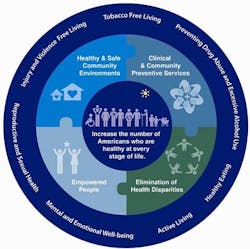Public Health Update: The goal of the National Prevention Strategy
National Prevention Strategy
The National Prevention Strategy’s goals are to guide the nation in improving health and well-being of all Americans with actions across multiple settings and partners.1 The government unaided cannot create healthier communities. The Strategy promotes cross-sector participation in building a prevention-oriented society. State, tribal, local and territorial government, business, health care, education, and community and faith-based organizations are all essential in this effort.
The goal is to “Increase the number of Americans who are healthy at every stage of life.”1 The four strategic directions are healthy and safe community environments; clinical and community preventive services; empowered people; and elimination of health disparities. The priorities developed as a result of the surgeon general’s strategies provide evidenced-based recommendations that are most likely to reduce the burden of the leading causes of preventable death and major illness. The priorities are designed to improve health and wellness for the entire U.S. population, including those groups disproportionately affected by disease and injury. For more information on these, and other information, go to the website.1
Community Health Advisor — Your resource for information on the benefits of evidence-based policies and programs
HealthPartners Institute for Education and Research and Partnership for Prevention have introduced an exciting new product to help public health leaders, decision-makers, and others who want to reduce smoking and increase physical activity in their community. The product, Community Health Advisor, is an online tool that provides customizable information about the potential health and cost impact of implementing evidence-based community interventions.2
Community Health Advisor starts with policies and programs recommended in The Community Guide. It builds on those recommendations by providing customizable information that community leaders can use. How would smoking rates or obesity prevalence change if policies and programs were implemented? What would be the impact of changes in smoking and physical activity rates on illness and death from cancer, cardiovascular disease, or other conditions? And how would medical care costs change with changes in health?
Breakfast is the Most Important Meal Of The Day
Having a meal within two hours of awakening can change the manner in which glucose, or blood sugar, is metabolized during the day. Glucose level rise after every meal and the pancreas produces insulin to transport the glucose into cells, where it is converted into energy. Research is finding that keeping glucose and insulin in the right balance has important effects on metabolism and health.
If one skips breakfast, extended fasting may cause a greater increase in hormones released when one is hungry, such as ghrelin. This may one to binge at the next meal, and could cause rise and fall in glucose. If the pancreas is continually producing insulin to compensate for high levels of glucose, it could break down and cause Type 2 diabetes.
Researchers from the University of Liverpool have established the effectiveness of a fiber-based dietary ingredient that makes people feel less hungry and consume less food. Hunger is a major obstacle to successful weight control and consumers need healthy foods that will help them control their appetite. Although fiber based foods have the potential to temper appetite without adding additional calories, they can make foods less appealing. Also, most studies on fibers have been unsuccessful in establishing positive effects on either appetite or food intake, and none have effects lasting the full day.3
Researchers tested the new product (Weightain satiety ingredient), consisting of a combination of dietary fiber sources including a viscous hydrocolloid and a whole-grain corn flour rich in resistant starch, to determine if it caused individuals to feel sated for longer periods of time, and influenced the quantity of food they consumed.3 The study found that food intake at both lunch and dinner times was lower when the satiety ingredient was given at breakfast, compared to the control and overall, after the 20g dose, 4% fewer calories were eaten and after the 30g dose, 5% food was eaten at both lunch and dinner combined.
Regarding breakfast, not all foods are created equal! Go to this site for a list of healthy cereals.4
Electronic Nicotine Delivery Systems - Report by the World Health Organization (WHO)
E-cigarettes and similar devices are often promoted by manufacturers as aids to quit smoking, or as healthier alternatives to tobacco, and require global regulation in the interest of public health. The new WHO report suggest that while e-cigarettes represent an “evolving frontier filled with promise and threat for tobacco control,” regulations are needed to impede e-cigarette promotion to non-smokers and young people; minimize potential health risks to e-cigarette users and nonusers; prohibit unproven health claims about e-cigarettes; and protect existing tobacco control efforts from commercial and other vested interests of the tobacco industry.5 The report on e-cigarettes to WHO Framework Convention on Tobacco Control is available in: Arabic, Chinese, English, French, Russian, and Spanish.6
Rare Flu Strains Could Be Key To Super-Vaccine - Research Suggests That Unfamiliar Flu Strains Cause Immune System To Release Broadly Effective Antibodies
Rare flu strains could be crucial to creating a super-vaccine. Research suggests that unfamiliar flu strains cause immune system to release broadly effective antibodies. The key to producing a universal flu vaccine is to discover a method of targeting the stem rather than the head of the virus. The stem mutates little and is less able to evade vaccine antibodies by changing the shape of its proteins, whereas the head reacts differently.7
Most Babies Vaccinated
A new federal report announced that the majority of babies born in the United States get vaccinated against potentially fatal diseases.8 The researchers found more than 90 % of children are getting the measles, mumps, and rubella (MMR), polio, hepatitis B and chickenpox (varicella) vaccines; from 2012 to 2013, the vaccination rate for rotavirus, which is an infection that causes severe gastrointestinal complication, increased from 69 % to 87 %; from 2012 to 2013, the vaccination rates for one or more doses of hepatitis A and hepatitis B increased from 82 to 83 % and 72 to 74 % respectively. Even though the rates for the initial vaccines are high, the rates for booster vaccines are not high. Electronic medical records may help.
Deadly Ebola
An Ebola vaccine being developed by the National Institutes of Health and GlaxoSmithKline (GSK) will soon be tested in humans. Unlike previous vaccines, the researchers are hoping to get a positive result when tested in humans. A small sample size of 20 will be a pilot for larger studies. GSK will have 10,000 doses of the vaccine available for immediate use if the pilot trial is successful.
References
- http://www.surgeongeneral.gov/initiatives/prevention/strategy/index.html.
- Community Health Advisor - http://communityhealthadvisor.org/.
- University of Liverpool. "Fibre-based satiety ingredient shown to make you eat less." ScienceDaily. ScienceDaily, 26 August 2014.
- http://greatist.com/health/best-healthy-cereal-brands.
- http://apps.who.int/gb/fctc/PDF/cop6/FCTC_COP6_10-en.pdf.
- http://www.who.int/nmh/events/2014/backgrounder-e-cigarettes/en/#.
- Ellebedy AH, Krammer F, Li G, Miller MS, et al. Induction of broadly cross-reactive antibody responses to the influenza HA stem region following H5N1 vaccination in humans. PNAS, August 2014 DOI: 10.1073/pnas.1414070111.
- CDC's Morbidity and Mortality Weekly Report. National, State, and Selected Local Area Vaccination Coverage Among Children Aged 19-35 Months - United States, 2013. http://www.cdc.gov/mmwr/preview/mmwrhtml/mm6334a1.htm?s_cid=mm6334a1_w.










